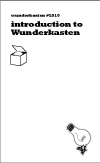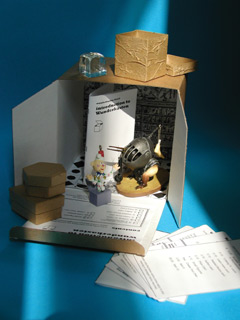How does it work?
In the service, learners browse through an online catalogue of available topics, and select those of interest to them, forming a topic queue. The first box in their queue is sent to them in the mail. The learner can keep the box and use its contents as long as he or she pleases. When finished, the learner uses their phone or Web form to arrange the return of their current box and, at the same time, the delivery of the next box in their queue.Alternate Forms
The cost and potential inconvenience may be deterrents. It is expensive to ship boxes, and the service would be priced to compensate. Additionally, some learners may find it inconvenient or difficult to arrange delivery or return. For learners looking for a less expensive or mailbox-only option, the idea might survive translation to "wunderkarten," or "wonder paper," which is an envelope-sized preprinted booklet whose content is similar, but whose activities would involve cutting up the pages or using common objects around the home or office. This implies that the learners do not return the booklets, and, instead, purchase each one and only have to return "next booklet" cards in the mail.How is this free range?
The Wunderkast boxes each contain something to wear, something to display, and something to hang. These serve as social signals for others in the learner's environment. When someone asks about any of them, the learner is prompted to speak about or explain what he or she is learning. This reinforces the learner's experience, and invites the listener to join the speaker's learning community. Giving the option to keep small objects from the box speaks to people's need for an artifact of their experience. It validates the time and money spent and acts as an environmental mnemonic.Format
 |
| PDF of the Introduction to Wunderkasten booklet |
- A label: including the title, topic, and contents list. The label introduces the box to the learner.
- A contents list: which acts as waybill at drop-off and pickup.
- A booklet containing main information about the topic: the primary text about the topic. It contains a basic text that can be read in about half an hour, explanations of the activities, and explanations of the contained activities and objects. It also details the authors of the contents.
- Learn more: a list of resources that tell learners where they can go to learn and do more about the topic.
- Related boxes card: which informs the learner about boxes related to the current one. Topics indicated include supersets, subsets, and laterally related topics. Inspired learners can check one of the related boxes to indicate that they would like this one added to their queue.
- Price card: which indicates the cost of any items the learner wishes to keep when they return the box.
- A fan-bound set of nine cards with intelligence links, explaining how this topic connects to the prior one, from the perspective of each of Gardner's nine intelligences. (Gardner 1983)
- A small coin-sized sticker showing the icon that represents the box and the title of the box. These stickers can be saved and connected on a poster as a visual reinforcement of the learner's journey through the boxes.
 |
| Other components from the Introduction to Wunderkasten |
- A solo activity
- A group activity
- Suggestions and materials for something to make
- Something to be worn
- Something to display on a desk, coffee table, etc.
- Something to hang from a lamp, a car's review mirror, etc.
- Miniature dioramas
- Mnemonic devices
- Games
- Paper dolls/puppets
- Topic examples
- Browse and queue the topics visually.
- Review their Wunderkast history: which ones they had, when they had them, and who has had that Wunderkast before them.
- Add comments, ratings, and suggestions to box summaries.
- Link to web pages or other resources related to the topic.
- Request the development of new Wunderkasten.
- Apply to become a Wunderkast author.

|
|
A prototype of the first Wunderkast that subscribers would receive.
|
Description of Use
-
Keiko uses Wunderkasten in Gets Fresh as a gift
References and Influences:
- Netflix: Netflix, a DVD-by-mail service, allows users to create and manage a DVD queue online. Netflix was the delivery model for the wunderkasten.
- Teknoteket: When this science-oriented Scandinavian children's magazine was still being published in the 1980ís, it included a small container with activities related to the magazine content with every issue. A fellow student of mine, Magnus, used to subscribe when he was a child, and recalled eagerly anticipating the arrival of each one.
- The Well Hung Art Company: Art can also easily habituate into the background of the userís attention. Services which let individuals change the art in their homes and business ensure that the signal is kept fresh.
- The Internet Movie Database: The deep interconnectedness of imdb.com encourages browsing and the construction of broad connections in the userís head. This influenced my decision to include the Related Boxes function of the service.
- Joseph Cornell: This artist’s body of work consists of boxes filled with mixed media collages.
- Discovery Suitcases: Dr. James Bradburne developed these suitcases while he was curator at MAK Frankfurt. Families can borrow a suitcase which leads them on an adventure trip through different collections of the museum. The suitcases contain exhibits to touch, smell and listen to, puzzles and games. The multi-channel nature of these suitcases and witnessing first-hand their success influenced the structure of what should go into each wunderkasten.
| NEXT> The scenarios. |